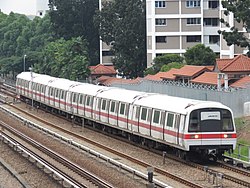Mass Rapid Transit (MRT) rolling stock
Current
| Line | Generation | Stock | Manufacturer(s) | Assembly | Image | Trainset statistics | Speed | Power | Introduction | Cost | |||||||||
|---|---|---|---|---|---|---|---|---|---|---|---|---|---|---|---|---|---|---|---|
| Number of train sets | Cars per train set | Total number of cars | Car length | Train set length | Car width | Car height | Trainset capacity | Seats | |||||||||||
| North–South Line | East–West Line | 4th | C151A | Kawasaki Heavy Industries & CSR/CRRC Qingdao Sifang | Qingdao, China |  | 35 | 6 | 210 | 23.83m (DT) 22.8m (M) | 138.86m | 3.2m | 3.7m | 1,920 passengers | 292 | 90 km/h (56 mph) (design) 80 km/h (50 mph) (service) | 750 V DC third rail | 27 May 2011 | S$368 million [3] |
| 5th | C151B |  | 45 | 270 | 16 April 2017 | S$281.5 million [4] | |||||||||||||
| 6th | C151C |  | 12 | 72 | 280 | 30 September 2018 [5] | $136.8 million | ||||||||||||
| 7th | R151 | Alstom (formerly Bombardier) & CRRC Changchun | Changchun, China |  | 106 | 636 | 228 | 4 June 2023 [8] [9] | S$1.5 billion [10] | ||||||||||
| North East Line | 1st | C751A | Alstom | Valenciennes, France |  | 25 | 150 | 23.65m (DT) 22.8m (Mp/Mi) | 138.5m | 296 (standard) 240 (high capacity) | 100 km/h (62 mph) (design) 90 km/h (56 mph) (service) | 1,500 V DC overhead catenary | 20 June 2003 | $260 million | |||||
| 2nd | C751C | Alstom & Shanghai Electric | Shanghai, China |  | 18 | 108 | 296 | 1 October 2015 | S$234.9 million [11] [12] | ||||||||||
| 3rd | C851E | Alstom | Barcelona, Spain |  | 6 | 36 | 28 July 2023 | S$249.9 million | |||||||||||
| Circle Line | 1st | C830 | Alstom | Valenciennes, France |  | 40 | 3 | 120 | 23.65m (Mc) 22.8m (T) | 70.1m | 931 passengers | 146 | 90 km/h (56 mph) (design) 80 km/h (50 mph) (service) | 750 V DC third rail | 28 May 2009 | S$282 million [15] | |||
| 2nd | C830C | Alstom & Shanghai Electric | Shanghai, China |  | 24 | 72 | 26 June 2015 | S$134 million [11] [12] | |||||||||||
| Downtown Line | 1st | C951 | Bombardier & CNR/CRRC Changchun | Changchun, China |  | 92 | 276 | 23.65m (DM) 22.8m (T) | 130 | 90 km/h (56 mph) (design) 80 km/h (50 mph) (service) | 22 December 2013 | S$689.9 million [16] [17] | |||||||
| Thomson–East Coast Line | 1st | T251 | Kawasaki Heavy Industries & CRRC Qingdao Sifang | Qingdao, China |  | 91 | 4 | 364 | 23.65m (DM) 22.8m (Mc/Tc) | 92.9m | 1,280 passengers | 156 | 100 km/h (62 mph) (design) 90 km/h (56 mph) (service) | 31 January 2020 | S$749 million [18] [19] | ||||
Future
| Line | Generation | Stock | Manufacturer(s) | Assembly | Image | Trainset statistics | Speed | Power | Introduction | Cost | |||||||||
|---|---|---|---|---|---|---|---|---|---|---|---|---|---|---|---|---|---|---|---|
| Number of train sets | Cars per train set | Total number of cars | Car length | Train set length | Car width | Car height | Trainset capacity | Seats | |||||||||||
| Circle Line | 3rd | C851E | Alstom | Barcelona, Spain |  | 23 | 3 | 69 | 23.65m (Mc) 22.8m (T) | 70.1m | 3.2m | 3.7m | 931 passengers | 146 | 90 km/h (56 mph) (design) 80 km/h (50 mph) (service) | 750 V DC third rail | Q1 2026 | S$249.9 million | |
| Jurong Region Line | 1st | J151 | Hyundai Rotem [20] | Changwon, South Korea |  | 62 | 3 (initial) 4 (final) | 186 (initial) | 18.6m (initial) [21] | 55.8m (initial) [21] | 2.75m [21] | TBA | 600 passengers (3-car config) 800 passengers (4-car config) | TBA | 70 km/h (43 mph) (design) | 2027 | S$416.5 million [22] | ||
| Cross Island Line | 1st | CR151 | CRRC Qingdao Sifang | Qingdao, China |  | 44 | 6 (initial) 8 (final) | 264 (initial) | TBA | 90 km/h (56 mph) (service) | 1,500 V DC overhead conductor rail | 2030 | S$589 million | ||||||
Retired
| Line | Generation | Stock | Manufacturer(s) | Assembly | Image | Trainset statistics | Speed | Power | Service | Cost | ||||||||||
|---|---|---|---|---|---|---|---|---|---|---|---|---|---|---|---|---|---|---|---|---|
| Number of train sets | Cars per train set | Total number of cars | Car length | Train set length | Car width | Car height | Trainset capacity | Seats | Introduction | Retirement | ||||||||||
| North–South Line | East–West Line | 1st | C151 | Kawasaki Heavy Industries, Nippon Sharyo, Tokyu Car Corporation, & Kinki Sharyo | Kobe, Japan [23] |  | 66 | 6 | 396 | 23.65m (DT) 22.8m (M) | 138m | 3.2m | 3.7m | 1,920 passengers | 372 (original) 296 (refurbished) | 90 km/h (56 mph) (design) 80 km/h (50 mph) (service) | 750 V DC third rail | 7 November 1987 | 26 September 2025 [24] | S$581.5 million |
| 2nd | C651 | Siemens | Vienna, Austria |  | 19 | 114 [27] [28] | 23.65m (DT) 22.8m (M) | 372 (unmodified) | 2 May 1995 | 27 November 2024 [29] | S$259 million [30] | |||||||||
| 3rd | C751B | Kawasaki Heavy Industries & Nippon Sharyo | Kobe, Japan |  | 21 | 126 | 23.83m (DT) 22.8m (M) | 138.86m | 272 | 28 January 2000 [33] | 7 December 2024 [34] | S$231 million | ||||||||







